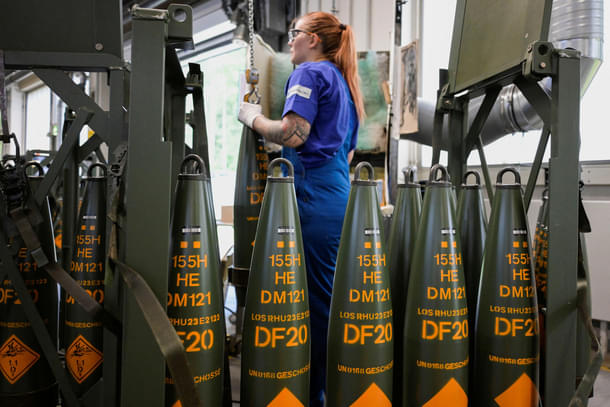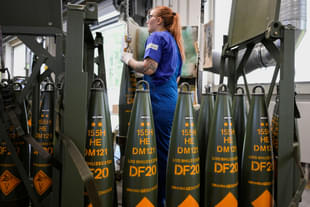World
Western Defence Giants Are The Only Winners In The Russia-Ukraine War
Ujjwal Shrotryia
Jun 21, 2024, 05:26 PM | Updated Aug 05, 2024, 03:54 PM IST
Save & read from anywhere!
Bookmark stories for easy access on any device or the Swarajya app.


The war in Ukraine continues to rage with no end in sight.
However, one clear victor has already emerged in this conflict: Western defence industry, which is making a killing from a record order book fuelled by heightened demand resulting from the Russia-Ukraine war.
For instance, North Atlantic Treaty Organization (NATO) spent $10 billion on ammunition, with $5.5 billion spent only on producing 1,000 Patriot air defence interceptor missiles, which will go to Lockheed Martin.
In January 2024, Germany's Rheinmetall started a production line that will make 50,000 155 mm artillery shells a month by next year and double this up by 2026.
Many more such orders have resulted in these companies reporting record profits and an exponential rise in stock price.
European majors are the predominant gainers of this, with Rheinmetall showing the largest uptick in its stock price, increasing by 315 per cent, while the United Kingdom's BAE Systems reported an increase of 105 per cent, and Thales 59 per cent, in the last two years.
US giants like Northrop Grumman and Lockheed Martin have also reported significant gains of 18 to 10 per cent respectively.
Saab, a Swedish defence giant, has seen its profits touching 30 per cent, an all-time high.
BAE Systems recorded profits of $3.3 billion in 2023, up 8 per cent from 2022. On the other hand, US' General Dynamics, which makes M1A2 Abrams tanks and nuclear attack submarines and destroyers, saw its revenue rise by 25 per cent.
Lockheed Martin and RTX (formerly Raytheon) have received combined orders totalling $30 billion with another $40 billion worth of orders on the anvil.
And there's more in the pipeline — replacement of army tactical missile systems with the newly designed precision strike missiles, guided multiple rocket launching system ammunition for HIMARS, Patriot interceptors, and AMRAAM air-to-air missiles, all of which were donated to Ukraine, leading to depletion of their US stockpiles.
The enthusiasm, fuelled by the large order book, is apparent in their hirings as well.
According to a Financial Times survey, the hiring requirements from these companies are at their highest level, as well, since the Cold War, with the firms looking to hire at least 37,000 skilled individuals in the short to medium timeframe.
For example, European ammunition manufacturers like Rheinmetall and Nammo have unveiled the most aggressive hiring plans. This is due to fulfilling large orders from European governments to replenish their stockpiles that have been depleted by donations to Ukraine.
Nammo, owned jointly by the Norwegian and Finnish governments, said that they have never been in such a situation before.
It increased its workforce by 15 per cent in 2021 to 2,700 and to 3,100 in 2023, with a target to double its workforce by the 2030s.
Similar is the situation for Germany's Rheinmetall, which makes tanks and infantry fighting vehicles. It is also hiring hundreds of employees from Continental, an auto parts maker.
Leonardo, the Italian defence major, said that it is hiring at such an intense rate that it has not seen even during the Afghanistan and Iraq wars. It is looking to induct 6,000 new employees by the end of 2024 and an additional 8,000 to 10,000 between 2025 and 2028.
Leonardo is working with the UK's BAE Systems and Mitsubishi of Japan to develop a sixth-generation fighter jet programme known as the Global Combat Air Programme.
France's Thales and Dassault are also on a hiring spree.
Thales, in the last three years, recruited 9,000 soldiers while Dassault Aviation, the maker of Rafale fighter jets (also operated by the Indian Air Force), which has recently seen major successes in selling Rafales to Gulf and Asian countries, is regularly hiring a skilled workforce.
Another European firm, MBDA, which makes Scalp-EG and Storm Shadow cruise missiles, also operated by the Indian Air Force from Rafales, is adding an additional 2,600 people, a 17 per cent increase in its current strength of 15,000.
The same story is true for US and UK defence majors.
United States companies Lockheed Martin (which makes F-35 and F-16 fighter jets), Northrop Grumman (B-2 Spirit and B-21 Raider stealth bombers), and General Dynamics are in the hunt for a combined 6,000 individuals.
Meanwhile, the United Kingdom's BAE Systems has doubled its intake over the past five years and will recruit an additional 2,700 this year.
BAE is on a long-term contract to deliver eight Type-26 frigates to the Royal Navy, 15 to the Royal Canadian Navy, and six to the Royal Australian Navy, and is also working on the development of the Global Combat Air Programme or Tempest sixth-generation fighter jet programme.
Most of this demand is for software or industrial engineers who can fulfill increased production, design, and development roles.
All this is on top of separate hirings for specialised nuclear roles.
It is forecasted that 30,000 skilled and specialised individuals will be required till 2030, mostly driven by the Australia-United Kingdom-United States (AUKUS) nuclear programme.
Under the AUKUS programme, the US and UK will provide Australia with new-generation nuclear attack submarines in the 2035-2040 timeframe.
Until then, US and UK nuclear submarines will have a presence in the waters surrounding Australia, apart from giving some buying or leasing of some nuclear submarines in the interim.
This will also help develop expertise in the Australian human workforce on specialised methods required to deal with anything nuclear.
With these record orders and hirings, it could be said with some conviction that the Western defence giants are the only winners in the Russia-Ukraine war.
Staff Writer at Swarajya. Writes on Indian Military and Defence.





